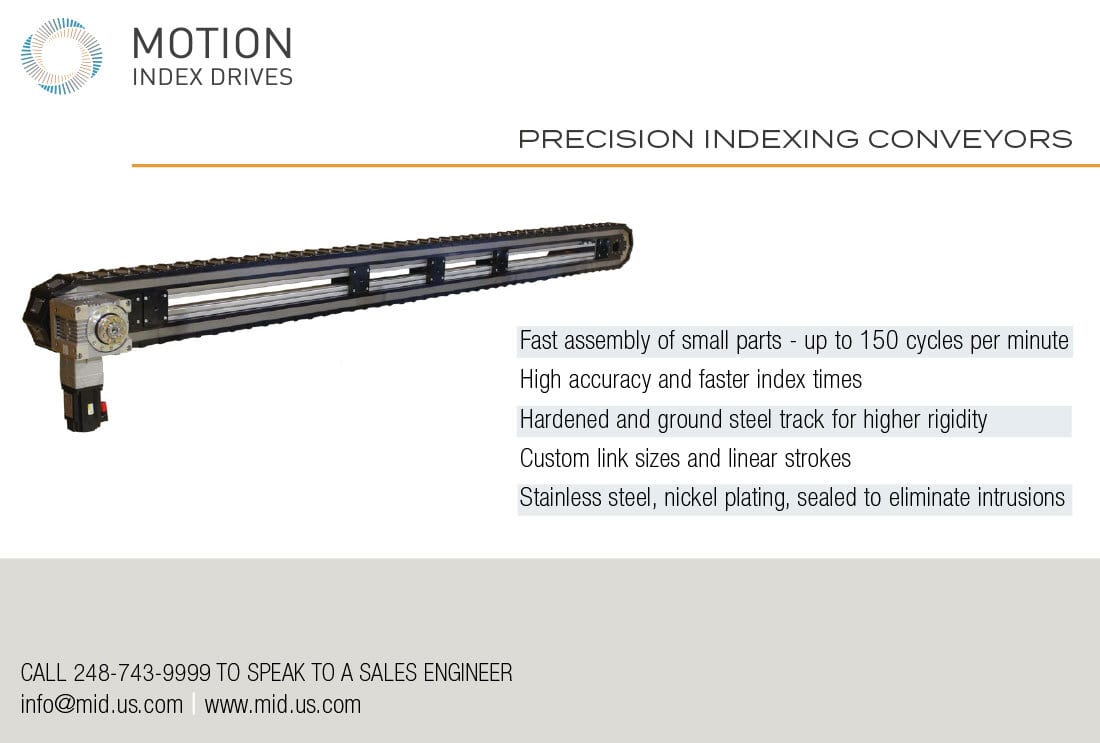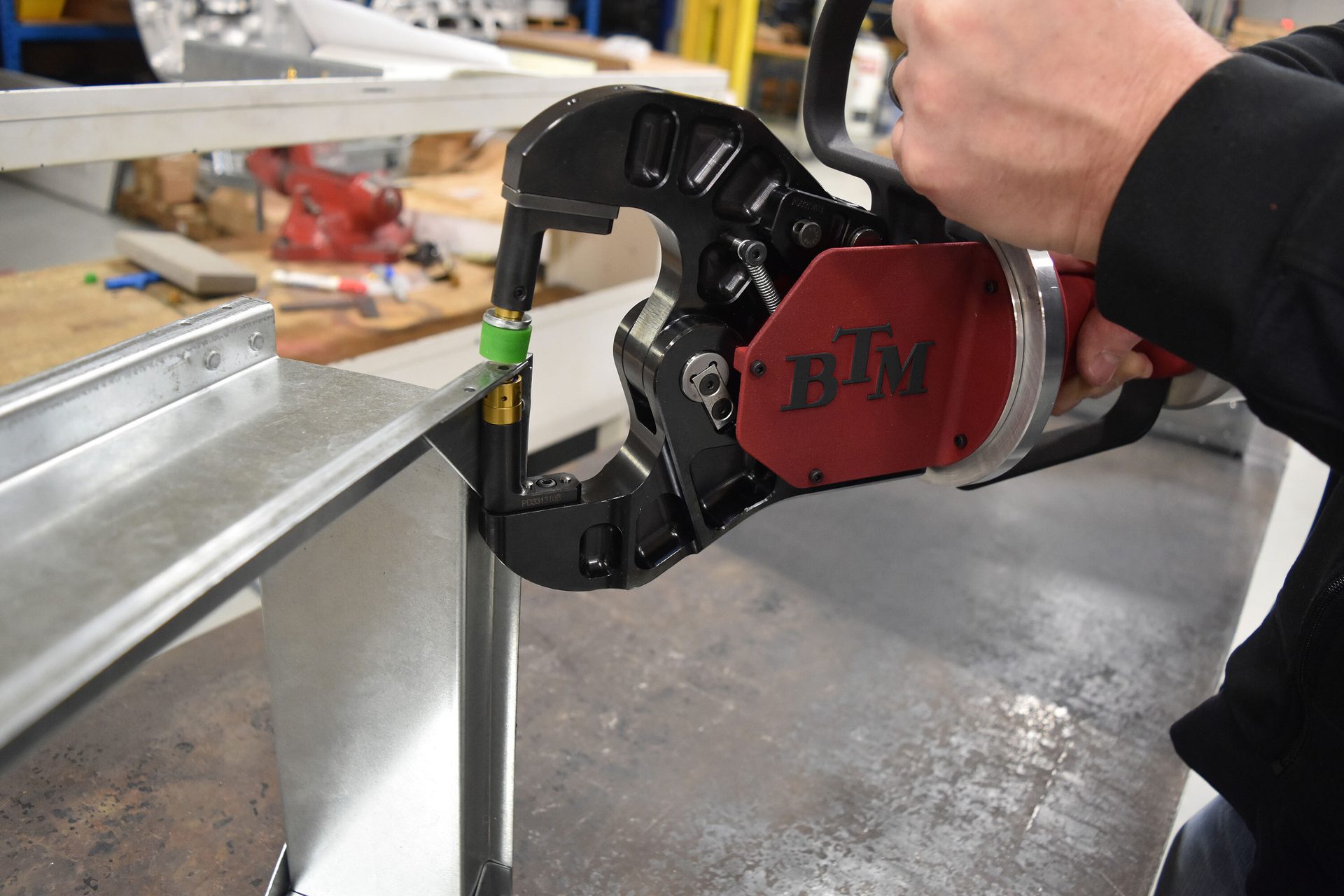Aerospace Industry
Two six-axis robots cooperate to rivet nut plates onto a fuselage component for an airplane. Photo courtesy Kawasaki Robotics
for Aerospace Assembly
Robots Coordinate
A trio of robots perform drilling, dispensing and riveting operations.
John Sprovieri // Chief Editor
Traditionally, aircraft assembly has been a labor-intensive, manual process. Robots have been a rare sight in aerospace manufacturing due to low production volumes and highly specialized parts.
That’s beginning to change, however. Robots are slowly becoming a key part of military and commercial aircraft assembly lines as the aerospace industry adopts new materials, grapples with throughput issues, and addresses ergonomic concerns and skilled labor shortages.
Such was the case when an aerospace supplier approached Canadian systems integrator Samuel Automation for help with a difficult assembly process. Based in Waterloo, Ontario, Samuel Automation was asked to design a complex robotic assembly cell for installing nut plates in aerospace components.
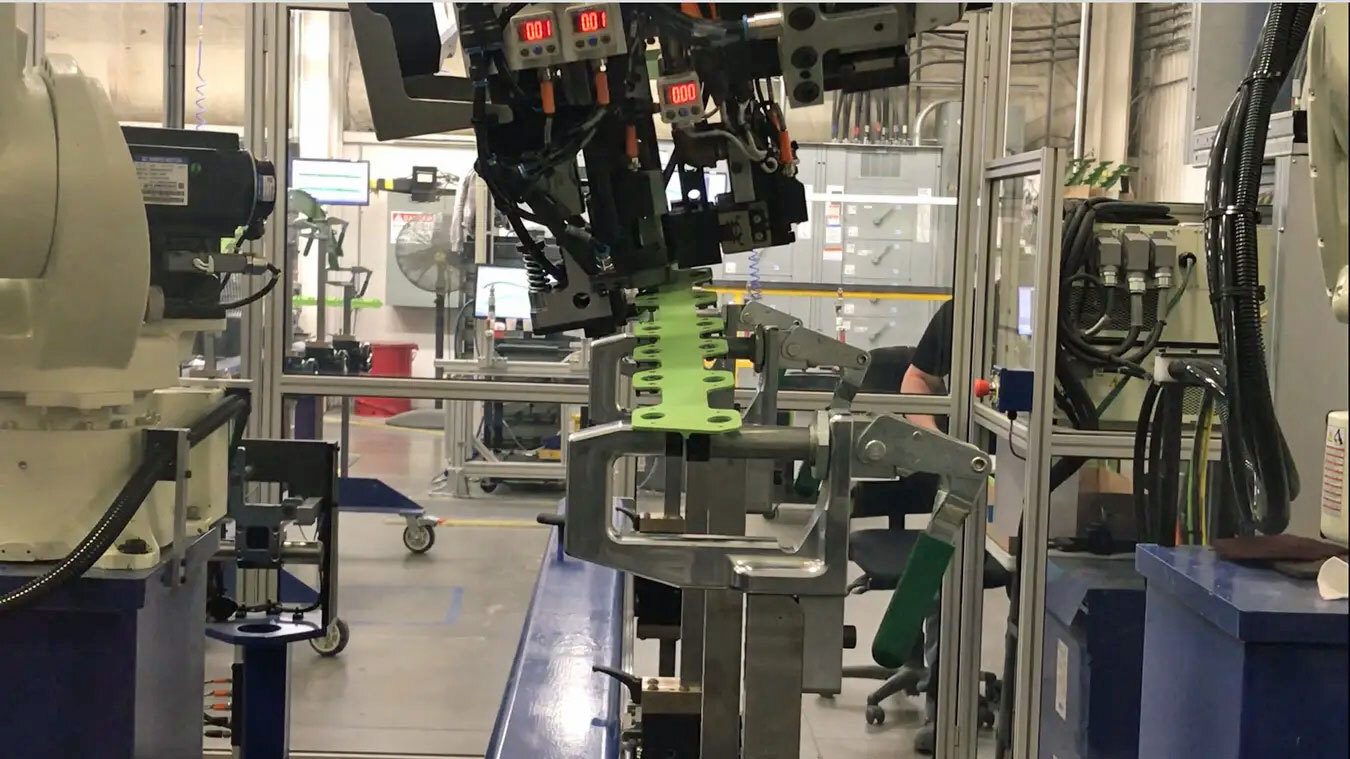
A robot drills and countersinks holes in an aircraft component. Photo courtesy Kawasaki Robotics
The nut plates are an irregular part with more than 200 variations. The fasteners are used to hold the external skin of the aircraft to the frame.
There were multiple reasons why the supplier wanted to automate the process of nut plate installation. For starters, to meet strict quality requirements, all employees had to undergo intensive training and certification for each part. They also had to document their work in real time. This, combined with the monotonous nature of the installation process, created employee retention issues for the manufacturer.
Quality control was another issue. Nut plates play an integral role in aircraft construction. The rivets used to secure the nut plates must be precisely installed. The rivet heights must be exact. Prior to automation, workers had to shave the rivets to the exact height needed, a tedious and time-consuming process.
Although this complex application did not necessarily sound like an ideal candidate for automation, Samuel Automation thought differently. Samuel engineers believed they could automate the process with vision-guided six-axis robots.
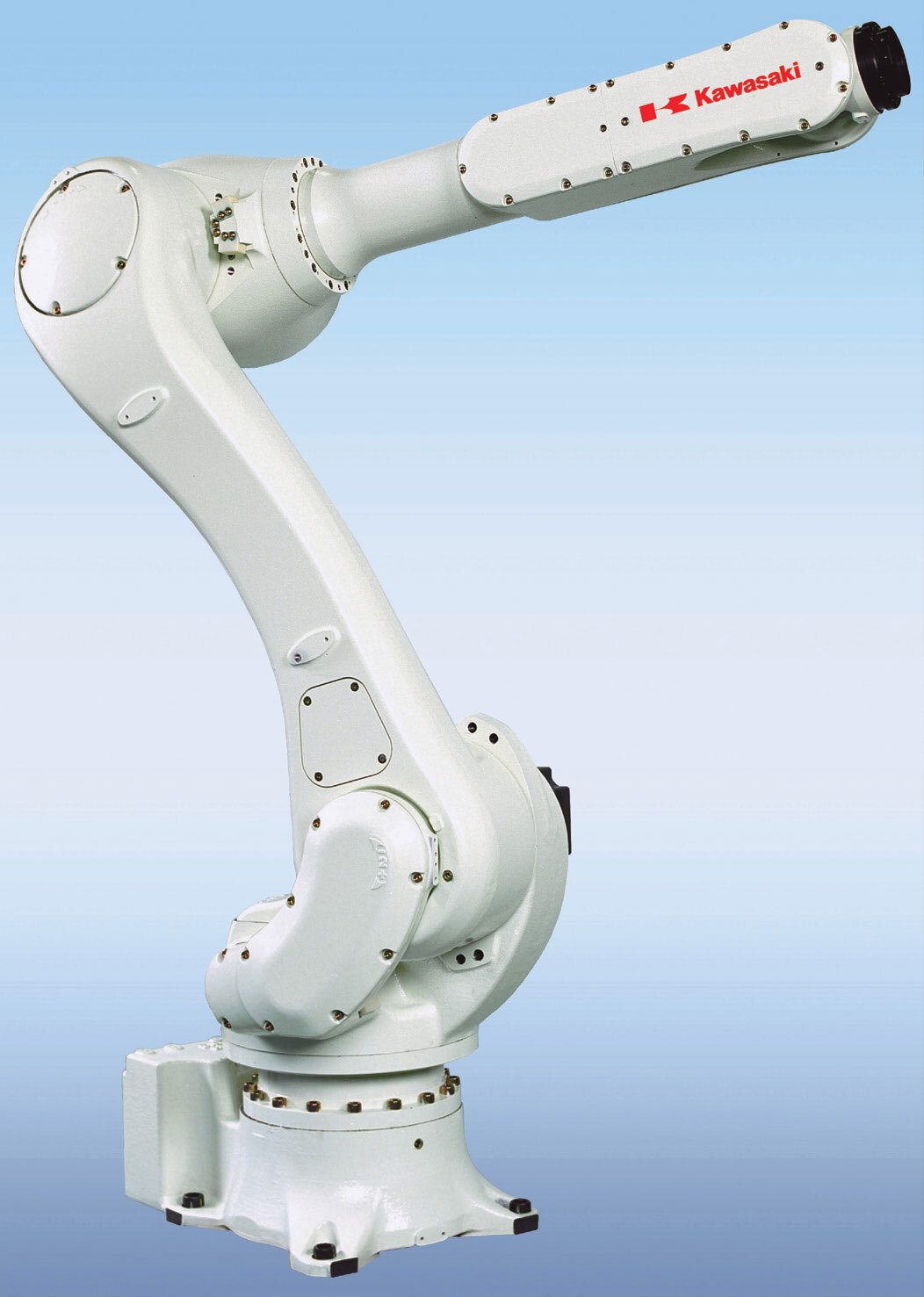
Kawasaki’s R Series robots are designed for applications requiring a long reach and small- to midsized payloads. Photo courtesy Kawasaki Robotics
Robotic Assembly Cell
Samuel Automation designed an automated assembly cell featuring three six-axis robots from Kawasaki Robotics. Vision systems locate and identify 225 part types.
At the first station, a Kawasaki RS080N robot determines the position of the base part by scanning three distinctive features using 3D vision and adjusting its position accordingly. The robot is equipped with a multipurpose end-of-arm tool (EAOT). One side is for drilling; the other side is for riveting.
After alignment, the RS080N’s EOAT grips the base part, then drills and countersinks two holes for the rivets that will be used to secure the nut plate.
Next, the robot rotates to retrieve the rivets for the assembly. There are four lengths to choose from, depending on the size of the plate.
While the RS080N is getting the rivets, a second robot—an RS010L—picks up a nut plate. A vision system verifies that it is the correct part. (There are 28 possible types.) The robot then places the nut plate in a special custom fixture. The fixture is designed to help the robot locate the nut plate accurately on the base part. A vision system checks the fixture to ensure it is clear to receive the nut plate.
Inspection System
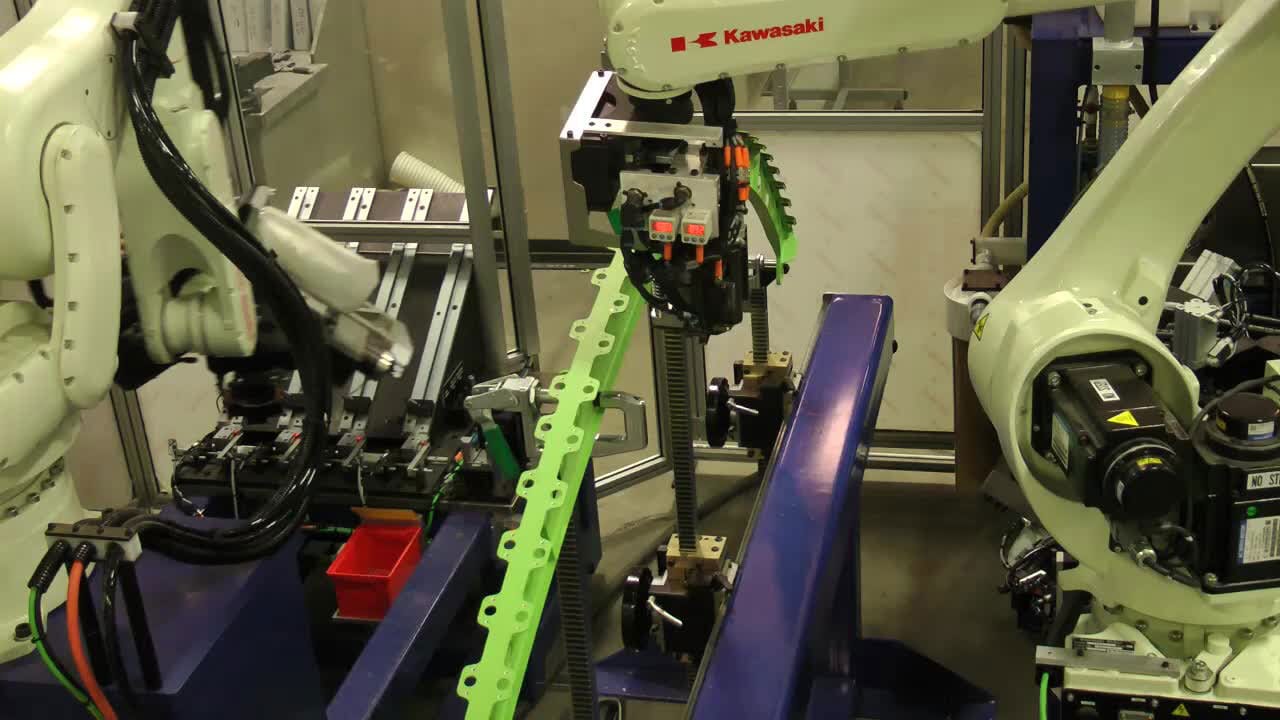
A vision system tells the robot the exactly location of this airplane component. Photo courtesy Kawasaki Robotics
Next, the RS010L places the nut plate and fixture assembly onto a turntable so a third robot—an RS005N—can apply sealant to help protect against corrosion. The RS005N conducts two vision checks: one before and one after sealant application.
Then, the turntable rotates so the RS010L can pick up the nut plate and fixture assembly and place it onto the base part. Prior to placement, the robot scans the base part to determine its exact position. While the RS010L robot holds the nut plate in place, the RS080N robot enters the area and the two heads marry to install the rivets.
After rivet installation, the robot heads separate. The RS010L safely releases the part and rotates to drop off the fixture. The RS080N rotates its EOAT to the correct position for rivet crimping, which completes the 39-second process.
Each robot has a different reach and payload capacity. The RS080N has a maximum reach of 2,100 millimeters and can carry a maximum payload of 80 kilograms. Positional repeatability is ±0.06 millimeter. The RS010L has a maximum reach of 1,925 millimeters and can carry a maximum payload of 10 kilograms. Positional repeatability is ±0.05 millimeter. The RS005N has a maximum reach of 705 millimeters and can carry a maximum payload of 3 kilograms. Positional repeatability is ±0.02 millimeter.
Samuel Automation chose Kawasaki robots because of their open architecture programming language and their ability to handle advanced processes.
A unique aspect of this application is how closely the robots work together. The heads of the RS080N and the RS010L must connect without colliding, an action that’s impossible without highly repeatable robots. Kawasaki’s R series of general purpose robots fit this criteria, with repeatability ranging from ±0.02 to ±0.06 millimeter as payload increases (3 to 80 kilograms).
The cell has been a success by many measures. Cycle time was reduced by 26 seconds, and the number of operators reduced from three to one. The cell creates a fully complete assembly; no work-in-progress stations are needed.
For more information on automated assembly systems, visit www.samuelautomation.com. For more information on industrial robots, visit https://kawasakirobotics.com.
ASSEMBLY ONLINE
For more information on automation in aerospace manufacturing, visit www.assemblymag.com to read these articles:

